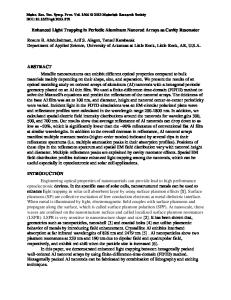Guided-mode resonance and field enhancement in semiconductor nanorod arrays
- PDF / 87,683,947 Bytes
- 8 Pages / 612 x 792 pts (letter) Page_size
- 85 Downloads / 370 Views
Guided-mode resonance and field enhancement in semiconductor nanorod arrays W. X. Yu1 and Y. Yi1,2* 1 2
University of Michigan, MI Massachusetts Institute of Technology, Cambridge, MA
ABSTRACT Guided mode resonance was numerically demonstrated in the tapered silicon nitride nanorod arrays on glass substrate. Finite difference time domain technique was employed to investigate the detailed light-matter interaction dynamics and the generation of resonance at femtoseconds. Enhanced electromagnetic (EM) field intensity with enhancement factor of 200~250 could be achieved. This highly concentrated electromagnetic field could be extended to the nanorod array tips and substrate for higher order resonance modes, which allows future application of this transverse propagating field in optical signal amplification, like fluorescence or Raman enhancement. INTRODUCTION Semiconductor nanorod arrays (NRAs) are widely studied for application in a wide variety of areas, such as antireflection, self-cleaning and superhydrophobicity[1-3]. NRAs with dimension from nanoscale to microscale could be fabricated using various template-assisted etching techniques. Dry etching technique is one of the most favorable fabrication methods due to its excellent controllability and compatibility with the CMOS technology. The periodic nano scale structures have attracted much attention in the research of nanophotonics. Guided mode resonance (GMR) was investigated using subwavelength grating as periodic reflectance surface[4-5]. Flexible tunability of resonance wavelength and high quality factor could be obtained. Focus has been in the potential application of GMR, like light filters[6-8], optical sensing[9-11], and detectors[12]. Recently, other interesting applications of GMR have been reported. Wu, et al coupled a two-filling-factor asymmetric binary grating on the solar cell and 3-fold enhancement of absorption was observed[13]. Lin, et al employed the GMR to enhance the two-photon photoluminescence with almost 360-fold, which is attributed to the strong local evanescent field in the grating waveguide[14]. The GMR could also excite the plasmonic modes when the silicon grating was integrated with the graphene monolayer, which could act as highly tunable optical filter or board band modulator[15]. Magnusson, et al has also proposed a coherent perfect absorber based on the amorphous Si grating on the glass substrate, which demonstrated a power absorption approaching 100% at 1.55 μm with its potential application on Si-based photonics[16]. In this letter, we have utilized the sub-wavelength tapered nanorod arrays (TNRAs) on the glass substrate to generate the GMR. Three-dimensional Finite difference time domain (FDTD) simulation has been performed to investigate the generation of the GMR, which exhibits high
electromagnetic (EM) field enhancement. The field distribution reveals that the location of the concentrated field could be tuned to extend to the nanorods or the substrate, which is important for the future applications of the GMR in optical s











